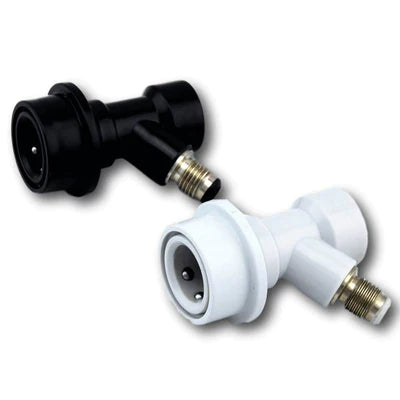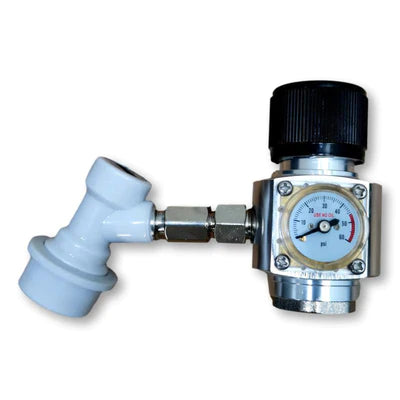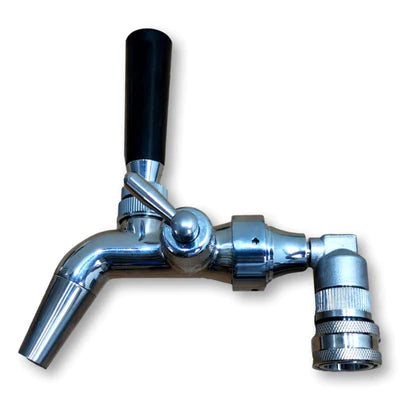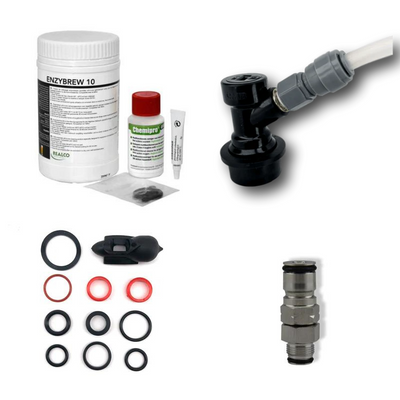Carbonation Guide: Force Carbonating, Pressure Brewing
This information applies to both storing and pouring pre-carbonated drinks (like a beer refill from a brewery or a rum and coke) or for homebrewers wanting to carbonate their brew / making your own sodas etc.
The most common questions we get asked about our gear is to do with pressure and carbonation. There is no single answer to why a beer is pouring foamy, why your cider tastes flat, what pressure you should store your keg at, how long it takes to carbonate etc. To answer any questions about carbonation you need some understanding of how CO2 (carbon dioxide, the gas that causes carbonation or fizz) absorption into liquid works.
We have tried to cover the information you need to know below so that you get the perfect carbonation level to suit your tastes.
- Liquid will absorb CO2 from the environment it is in (in this case a keg or other pressurised vessel).
- The colder the liquid the faster CO2 will be absorbed into it and the more CO2 will stay absorbed.
- The higher the pressure the faster CO2 will be absorbed and the more CO2 will stay absorbed.
- The larger the surface area between the CO2 and the liquid the faster the CO2 will absorb.
- The liquid can hold a maximum amount of CO2 at any fixed temperature and pressure, once it reaches that no more will absorb, so long as the pressure and temperature don't change.
With this information it is easy to see that the fastest way to make a flat liquid carbonated would be to chill it, put high pressure co2 in the keg with it and shake it (which maximises the surface area of liquid and gas touching each other). Many people at least start the carbonation process like this to speed up the overall time taken. The problem is you have very little control of how carbonated the liquid will become.
A much more accurate method is to know exactly how much CO2 you want in your drink (how carbonated you want it - this is measured in volumes of CO2 for those with some chemistry background) and then store it at a temperature and pressure where it will stop absorbing CO2 when it gets to that point.
This is what is shown on the table below. The colour coding is for various levels of carbonation, depending on the beer style (sodas are highly carbonated so treat rum and coke or soda water like the orange band)
- The most common styles (lager, ale, amber) have around 2.5 volumes of CO2 dissolved in them to be perfectly carbonated and are represented by the yellow band across the centre.
- After deciding which colour band you need, choose the temperature your liquid is being stored at (example a fridge at 5 deg).
- Find this temperature on the left side and follow it across till you hit the colour of your beer style (in our case we would hit the yellow band in the 5 columns just to the left of centre).
- This tells us that we would need to set our CO2 pressure to 9-13 PSI to get the correct level of carbonation by looking at the x-axis along the bottom.
With this method you will never over carbonate your drink, whether you bought it already carbonated or you are carbonating your own it doesn't matter.
If you are carbonating with this method a chilled 19L keg will take about a week, smaller kegs will take less time but there is no set time, it takes as long as it takes. It will take longer to carbonate than if you used high pressure and shook or rolled the chilled keg.
Once it reaches the right level (or if your drink was already carbonated), your regulator will stop injecting gas until you remove some liquid. When liquid is removed, the regulator will add more gas to keep the pressure and carbonation level constant.
You can try a bit of your drink to see if it is carbonated enough at any point. Once it reaches the right level you can either leave the regulator attached and turned on or remove it and only attach it again when you want to pour drinks from the keg. You will not use any less gas by removing the regulator EXCEPT if you have a gas leak.
NOTE: If using a check valve (either a check valve disconnect or an inline check valve on the gas line) the regulator is not showing you the pressure in the keg. It is showing you the pressure in the space between the regulator and the check-valve. If the pressure in the keg rises due to increased temperature it will not register on the regulator dial as the check-valve is preventing it. If it falls it will need to fall by a few psi below the set pressure on the regulator before the valve will open to let more gas in. In short, if you are using a check valve you will not have an accurate reading on the gauge of the regulator. We suggest using the check valve only when needed (the keg is lying down) to prevent inaccuracies in your pressure setting.
Carbonation Table - Temperature, Pressure and Beer Style
Brewing Under Pressure (Carbonate While Fermenting)
- You will notice that the temperature range in the table below go up far above fridge temperature. This is for when you are brewing beer in a pressure fermenter like the Fermzilla, Fermentasaurus or King Jr.
- A pressure fermenter can handle pressure building up inside it, which happens as CO2 is produced during fermentation.
- Say you are brewing ale at a room temperature of 24 degrees with a spunding valve attached (which is an adjustable pressure release valve, you set it at what you want the pressure of the vessel to be and it vents any gas pressure above that level),
- If you set the spunding valve to vent anything above 29psi, when your beer finishes brewing it will have used the CO2 produced during brewing to carbonate it at the same time so it is ready to drink!
- You just need to chill the brew down and either attach a tap or transfer it to a keg for tapping.
- This saves you both time waiting for carbonation afterwards and money on gas as the CO2 from fermentation is used!
Transferring Under Pressure (From Fermenter to Keg or Keg to Keg)
Methods to measure when the keg is full
-
- Watch the condensation line on the outside of the empty keg rising.
- Have the empty keg on a zeroed set of scales and use the fact that 1 litre of liquid weighs 1kg to measure.
- Use one of our flow stoppers with the spunding valve. This automatically stops the flow once the keg is full.
- Sanitise and flush your keg with CO2 to remove any oxygen
- Pressurise your empty keg to the same as the source vessel (if you connect the two gas posts they will equalise)
- Set your spunding valve to the same pressure (connect it to a regulator and adjust)
- Connect the liquid posts together with 2 x liquid disconnects and some beer line.
- Attach the spunding valve to the gas post of the empty vessel.
- Attach your regulator to the gas post of the full vessel.
- Turn up the pressure on the regulator to slightly above the empty vessel pressure
- Wait till transfer is complete.







